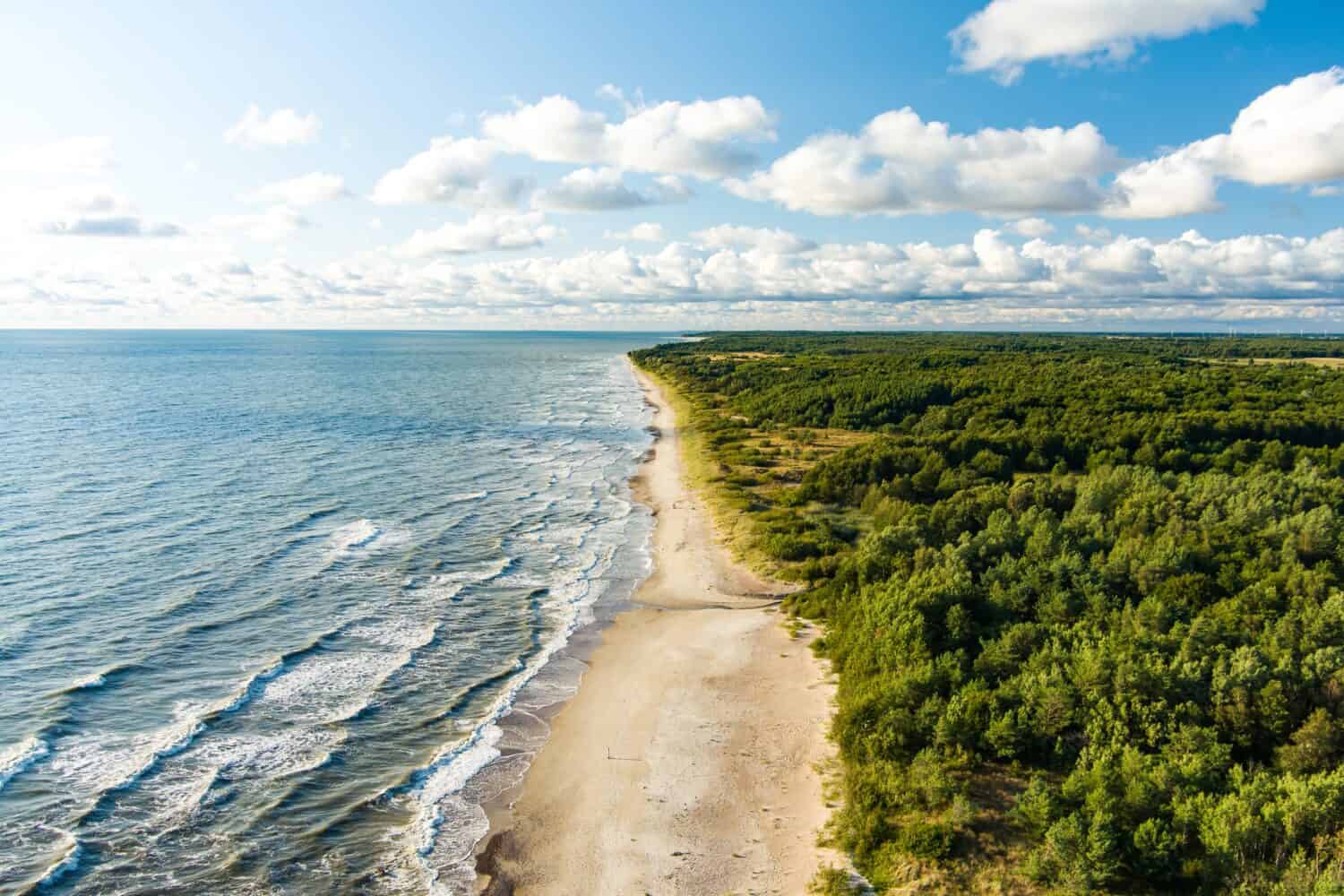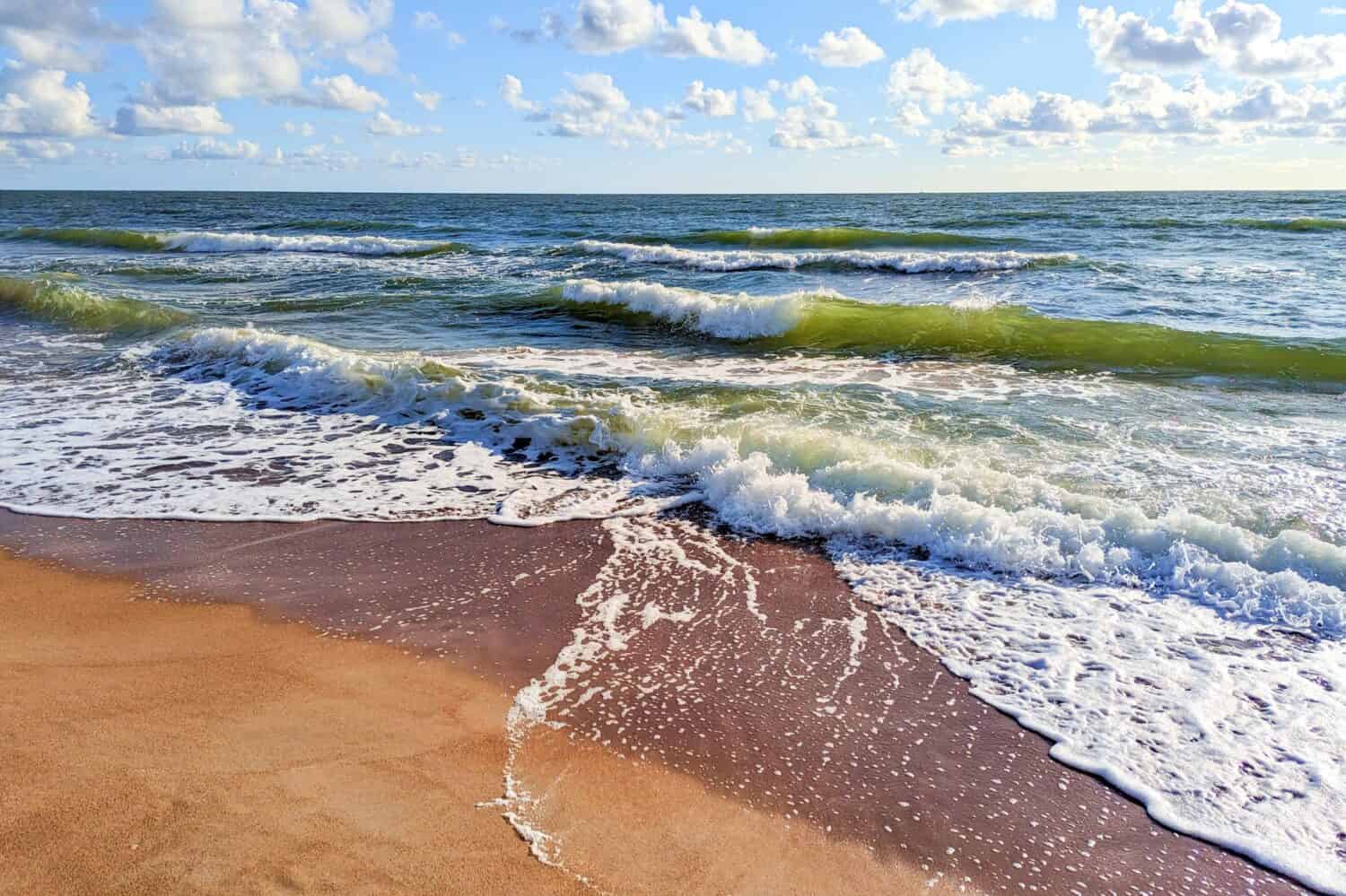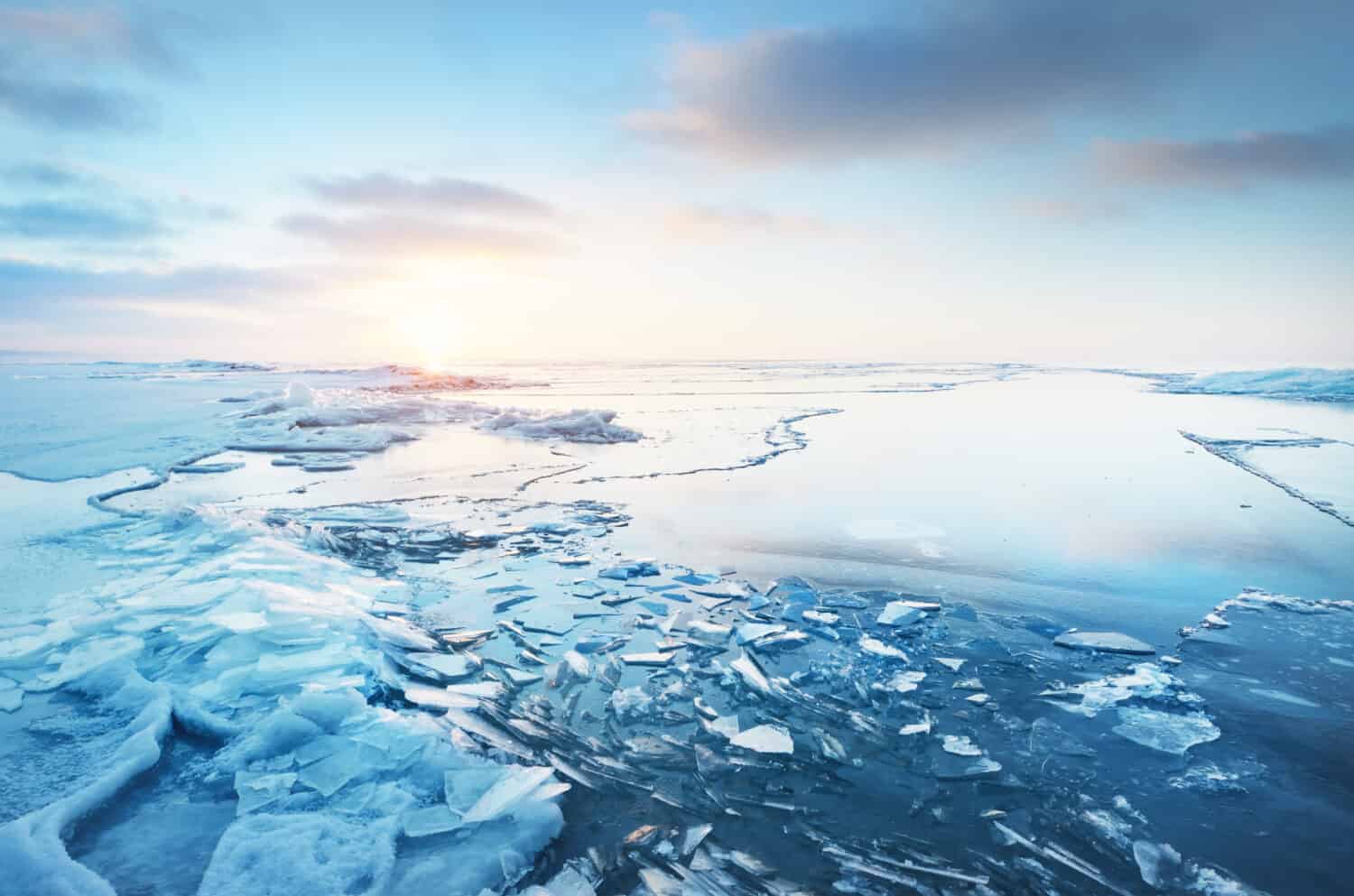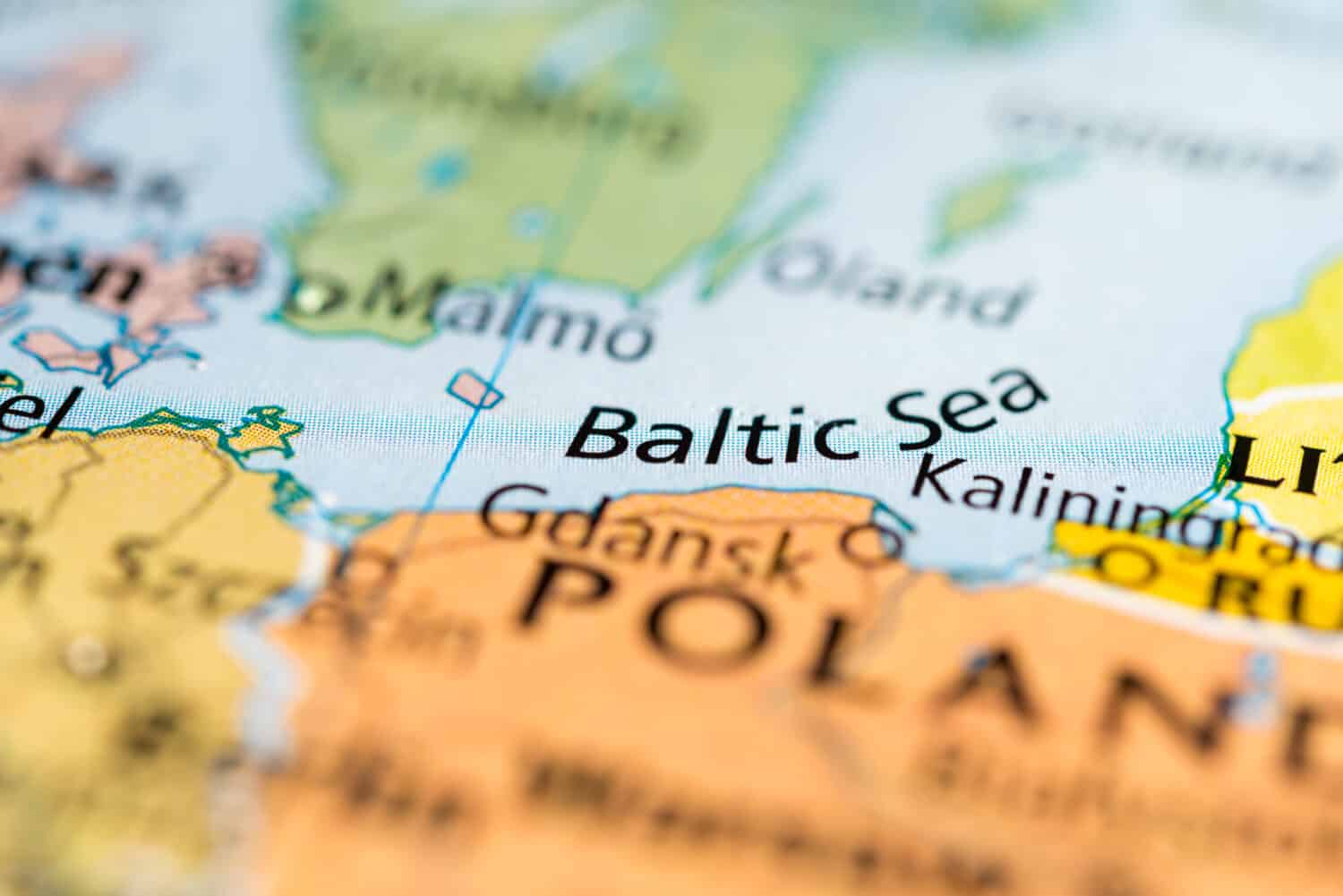The Baltic Sea is an arm of the Atlantic Ocean that surrounds nine countries. Speaking of arms, the Baltic Sea if you look more closely, looks like a human. But the Baltic Sea is also so much more. It is a unique body of water that is home to both saltwater marine life and freshwater marine life. Birds and mammals of all kinds inhabit the areas around the sea because of how diverse the climate is in the lands surrounding it. The history of the Baltic rivals the bodies of water throughout the world.
Let’s explore 10 amazing facts about the Baltic Sea. We’ll go over each point in more detail and provide you with fun facts about the sea that will leave you in awe.
Brackish Sea

The Baltic Sea is the largest inland brackish sea in the world.
©MNStudio/Shutterstock.com
The definition of brackish water means that the body of water is more saline than freshwater, but less saline than other bodies of water that are normally saline. That is to say that usually seas connected to oceans are saline, but the Baltic Sea is brackish. The reason? Because the Baltic Sea begins at the straits of Denmark, which are narrow and shallow, the sea is less salty and more shallow. Because 25% of the water it receives is freshwater, the sea is more likely to freeze over, especially near the Gulf of Bothnia (in the north of Sweden and Finland).
Younger Body of Water

The Roman Empire referred to the Baltic Sea as Mare Sarmaticum or Mare Suebicum.
©Igor Shoshin/Shutterstock.com
The Baltic Sea was formed about 10,000 years ago and thus, it is a relatively younger body of water than its counterparts. The Baltic Sea is also quite shallow. The maximum depth of the sea is 1,506 feet, located near Sweden. The average depth, however, is about 180 feet, while the average length is 990 miles and the average width of the sea is 120 miles.
Baltic Climate

The Gulf of Finland was completely frozen on February 15, 2011.
©Aastels/Shutterstock.com
The Baltic Sea has a unique climate. The winters are very cold and long, while the summers, which are warm, last much shorter than usual. These cold winters also are exacerbated by the freezing of the water in the northern areas of the sea. Interestingly enough, the Baltic Sea’s climate also changes as time passes — ranging from a maritime climate to continental weather. When it comes to precipitation, it usually ranges between 20 to 24 inches per year. The sea is also quite a foggy sea throughout the year.
Diverse Wildlife

The Baltic Sea is home to more than 200 harbors.
©Romashko Yuliia/Shutterstock.com
Because the Baltic Sea is brackish, it is home to both marine and freshwater species. Thus, the sea is extremely diverse, home to more than 2,000 species of wildlife. This makes things fascinating for scientists who witness these species coexist with one another. The Baltic Sea is home to a variety of fish including Atlantic herring, European flounder, Atlantic cod, European perch, and many more. It is also home to the shore crab and the common starfish, as well as the blue mussel, which is the most common species in the sea. You can also spot beluga whales, orcas, minke whales, and humpback whales.
Unfortunately, the sea has an overabundance of algae blooms. They pop up in the summer and can stretch from Germany all the way north to Finland. They pose a risk to humans and threaten marine life in the sea, as well.
Abundance of Archipelagos

Major cities that sit on the Baltic Sea include Copenhagen, Denmark; Stockholm, Sweden; Helsinki, Finland; St. Petersburg, Russia; Tallinn, Estonia, Riga, Latvia; Klaipeda, Lithuania, and Gdansk, Poland.
©valkird/Shutterstock.com
The Baltic Sea is home to dozens of islands and archipelagos. When you explore the countries of Sweden, Denmark, and Sweden, especially, you get to traverse through many islands and archipelagos to get to the mainland. This is especially poignant in Sweden. The largest island in the Baltic Sea is Gotland, off the coast of Sweden. It is 1,156 square miles and serves as a tourist destination for many Swedes and others during summer.
Viking History

The Baltic Sea borders nine countries: Denmark, Sweden, Finland, Estonia, Latvia, Lithuania, Russia, Poland, and Germany.
©Tudoran Andrei/Shutterstock.com
The Baltic Sea has an impressive Viking history known for its extensive trading routes. Scandinavians created a trading empire throughout the sea. The Norse Vikings used Russian rivers as trade routes as well and fought off tribes seen as enemies. The Vikings used the sea for fishing, but the sea also provided them with amber and other deposits. They also called the Baltic Sea, “Eastern Lake.”
World War Battles

An underground tunnelway, the Fehmarn Belt tunnel, is being constructed to connect Denmark and Germany and will be finished in 2029.
©Juan_Hernandez/Shutterstock.com
The Baltic Sea has long seen battles take place on its waters. From the Viking Age where the Norse Vikings fought off enemies in land and sea battles to more modern wars that catapulted Russia as a major power in the Baltic Sea. The most prominent battles in Baltic Sea history, however, took place during World War I and World War II. Both sides of each war saw the Baltic Sea as a battleground.
During World War II, Nazi Germany occupied the Baltic States and the sea ended up being a mass grave for soldiers and other casualties of war. MV Wilhelm Gustloff was a German military transport ship that the Soviets sank, killing more than 9,000 people. It was the deadliest maritime disaster in history.
Commercial Fishing and Tourism

The Baltic Sea provides all surrounding countries with a combined 5,000 miles of shoreline.
©Shaiith/Shutterstock.com
The Baltic Sea has been home to commercial fishing for hundreds of years. The economies of the countries surrounding the sea rely on commercial fishing in the region. There is also a steady amount of tourism around the Baltic Sea with many different beaches and tourist resorts popping up around the sea over the years.
Environmental Pollution

More than 85 million people live in countries near the Baltic Sea, partly responsible for the pollution in the sea.
©mivod/Shutterstock.com
The Baltic Sea is one of the most polluted bodies of water in the entire world. Ever since World War II, the sea has been a dumping ground for the surrounding countries’ waste. There are airplanes, warships, and other war materials at the bottom of the sea. But there are also microplastics, agricultural runoff waste, and chemicals in the sea. The pollution is so bad that there are dead zones in the Baltic Sea. These dead zones smell like rotten eggs because of the nutrients from the pollution. This is also what creates the overabundance of the toxic algae blooms in the sea. In recent years, there have been efforts by governments and organizations to clean up the sea and pass more stringent, environmentally-friendly laws.
Baltic Sea Anomaly

The Baltic Sea was called other names in the Middle Ages and the name “Baltic” was settled as its common name around 1600.
©Aastels/Shutterstock.com
This has to be the weirdest, most amazing fact about the Baltic Sea ever. In June 2011, a group of Swedish divers were treasure hunting when they discovered an odd sonar image on the bottom of the Baltic Sea. Tabloids published in their newspapers that it could have been a UFO because the Swedish divers stated the object was odd and not seen in nature. Scientists later concluded that the image is a natural geological formation.
Conclusion
And there you have it, these are 10 amazing facts about the Baltic Sea. The sea is unique in that it is less saline than other seas around the world. The sea is steeped in a rich history that stretches from the Viking days to two world wars. The countries surrounding the Baltic Sea consider it an important sea commercially, tourism-wise, and militarily.
If you get the chance to visit some of these nine countries surrounding the Baltic Sea, think about the beauty, diversity, and history of this amazing sea.
The photo featured at the top of this post is © RicoK69/iStock via Getty Images
Thank you for reading! Have some feedback for us? Contact the AZ Animals editorial team.






